Analysis of the Dynamic Process of Tornado Formation on 28 July 2024
Abstract
1. Introduction
2. Materials and Methods
2.1. Data Sheet
2.2. Weather Background and Tornado Observation
2.2.1. Weather Background
2.2.2. Tornado Observation
2.3. Research Methods
2.3.1. Three-Dimensional Direct Synthesis Wind Field Algorithm
2.3.2. Vorticity and Divergence
2.3.3. Vorticity Volume
2.4. Data Comparison and Validation
2.4.1. Echo Intensity Comparison
2.4.2. Radial Velocity Comparison
3. Results
3.1. Tornado Genesis and Development Stages
3.2. Tornado Mature Stage
3.3. Tornado Dissipation Stage
4. Discussion
4.1. Initial Construction of Vorticity Volume
- Addressing the ambiguity of vortex boundaries: Fluid vorticity fields exhibit continuity and there are no absolute vortex boundaries. Thresholds introduce intensity thresholds to separate physically significant rotational structures from background vorticity and weak vorticity noise, thereby objectively defining the spatial extent of vortices.
- Quantifying vortex-dominated regions: The calculation of vorticity volume depends on the identification of significant vortex regions.
- Suppressing non-physical interference: The threshold can filter out discrete errors, maximising the assurance that the extracted vortex structures reflect real physical processes rather than numerical counterfeit.
- The threshold is calculated using a method based on the vortex core method combined with statistical analysis. The specific steps are as follows: Calculate the three-dimensional vorticity field using three-dimensional wind field data, and then calculate the vorticity magnitude field (each grid point has only one vorticity magnitude value). Iterate through all the time steps of the vorticity magnitude values find the median value, and then set it as the environmental vorticity.
- For each time step, iterate through the vorticity magnitude field at each layer height to identify vorticity cores; i.e., local maximum points (determine whether the point is the maximum value within its neighbourhood (9 × 9)).
- Count the number of vorticity values that are adjacent to the vortex core and greater than the environmental vorticity at all time steps and heights.
- Calculate the root mean square of all qualified vorticity values to obtain the threshold, as shown in Formula (5):
- Calculate the vorticity field using three-dimensional wind field data. Based on the obtained threshold , apply a step function to determine whether the vorticity of the vortex exceeds the threshold, thereby binarising the vorticity field.
- Using the connected domain (eight-connected) method, identify the connected domains at each height layer of the vortex and count the number of grid points in the connected domains that meet the conditions at each height layer of the vortex.
- To ensure vertical continuity, first calculate the area of the connected domains that meet the conditions at each height level. Based on the resolution of the three-dimensional grid point data (100 m × 100 m × 200 m), the area is equal to the number of grid points in the connected domain multiplied by 10,000 m2.
- Use the common area ratio method to ensure vertical continuity. The common area ratio formula is as follows:
- Finally, the vorticity volume is equal to the total number of grid points multiplied by the unit volume (i.e., total number of grid points × 2,000,000 m3).
4.2. Analysis and Discussion of the Vorticity Volume
5. Conclusions
- The tornado displayed classic supercell features, such as hook echoes and a weak echo centre. During its early development, arc-shaped strong echoes appeared about 14 min prior, with annular echoes emerging at 00:18, mainly between 0 and 4 km. A weak echo area formed at the tornado centre. After 00:24 (tornado occurrence), the annular echoes gradually reverted to being arc-shaped, and echo features eventually disappeared as the tornado dissipated.
- The tornado vortex moved roughly from south to north. Before 00:20, vorticity was low but increasing. From 00:10 to 00:24, vortex depth and vorticity grew, peaking at 00:24, which is when the positive vorticity centre reached the ground. After 00:25, vorticity declined, indicating tornado dissipation and, by 00:30, it nearly vanished. The positive vorticity centre showed divergence on the tornado’s movement side and convergence on the opposite side.
- To assess the vortex structure’s overall rotation and distribution, this study introduced vorticity volume, analysing two tornadoes (28 July 2024 and 18 June 2022). The total vorticity area across height layers gradually increased in the tornado’s early stage, peaked at maturity and then rapidly decreased. Similarly, vorticity volume rose from the initial stage, peaked at tornado occurrence and then decayed until dissipation, closely aligning with the tornado life cycle.
Author Contributions
Funding
Data Availability Statement
Acknowledgments
Conflicts of Interest
References
- Diao, X.; Meng, X.; Zhang, L.; Ren, Z.; Zhao, H. Analysis of microscale vortex signature and early warning capability of tornadoes in the circulations of Typhoon YAGI and RUMBIA. J. Mar. Meteorol. 2019, 39, 19–28. [Google Scholar]
- Brotzge, J.; Donner, W. The Tornado Warning Process: A Review of Current Research, Challenges, and Opportunities. Bull. Am. Meteorol. Soc. 2013, 94, 1715–1733. [Google Scholar] [CrossRef]
- Squitieri, B.J.; Wade, A.R.; Jirak, I.L. A historical overview on the science of derechos: Part I: Identification, Climatology, and Societal Impacts. Bull. Am. Meteorol. Soc. 2023, 104, E1709–E1733. [Google Scholar] [CrossRef]
- Crum, T.D.; Alberty, R.L. The WSR-88D and the WSR-88D operational support facility. Bull. Am. Meteorol. Soc. 1993, 74, 1669–1688. [Google Scholar] [CrossRef]
- Crum, T.D.; Saffle, R.E.; Wilson, J.W. An update on the NEXRAD program and future WSR-88D support to operations. Weather Forecast. 1998, 13, 253–262. [Google Scholar] [CrossRef]
- Berkowitz, D.S.; Schultz, J.A.; Vasiloff, S.; Elmore, K.L.; Payne, C.D.; Boettcher, J.B. Status of Dual Pol QPE in The WSR-88D Network. Am. Meteorol. Soc. 2013. [Google Scholar]
- Ryzhkov, A.V.; Schuur, T.J.; Burgess, D.W.; Zrnic, D.S. Polarimetric tornado detection. J. Appl. Meteorol. 2005, 44, 557–570. [Google Scholar] [CrossRef]
- Bluestein, H.B. Severe Convective Storms and Tornadoes; Springer: Berlin/Heidelberg, Germany, 2013; Volume 10, pp. 973–978. [Google Scholar]
- Lemon, L.R.; Doswell, C.A., III. Severe thunderstorm evolution and mesocyclone structure as related to tornadogenesis. Mon. Weather Rev. 1979, 107, 1184–1197. [Google Scholar] [CrossRef]
- Trapp, R.J.; Mitchell, E.D.; Tipton, G.A.; Effertz, D.W.; Watson, A.I.; Andra, D.L.; Magsig, M.A. Descending and nondescending tornadic vortex signatures detected by WSR-88Ds. Weather Forecast. 1999, 14, 625–639. [Google Scholar] [CrossRef]
- Anderson-Frey, A.K.; Richardson, Y.P.; Dean, A.R.; Thompson, R.L.; Smith, B.T. Investigation of near-storm environments for tornado events and warnings. Weather Forecast. 2016, 31, 1771–1790. [Google Scholar] [CrossRef]
- Wei, W.; Zhao, Y. The characteristics of Tornadoes in China. Meteorol. Mon. 1995, 21, 36–40. [Google Scholar]
- Zhang, G.; Li, Y.; Jiang, J.; Chang, X.; Huo, Z.; Zhong, X.; Guo, B.; Jia, K. Characteristic Analysis of EF3 Strong Tornado Induced by Multiple Supercell Storms. Meteorol. Mon. 2023, 49, 1315–1327. [Google Scholar]
- Liu, J.; Zhu, J.; Wei, D.; Song, Z.; Lu, H.; Zhou, H. Doppler Weather Radar Typical Characteristics of the 3 July 2007 Tianchang Supercell Tornado. Meteorol. Mon. 2009, 35, 32–39. [Google Scholar]
- Song, Z.; Liu, J.; Zhang, J.; Lu, H.; Xiang, Y. Analysis of a severe Tornado in lingbi county with Doppler radar fuyang CINRAD/SA’s products. J. Meteorol. Sci. 2006, 26, 689–695. [Google Scholar]
- Yu, X. Detection and Warnings of Severe Convection with Doppler Weather Radar. Adv. Meteorol. Sci. Technol. 2011, 1, 31–41. [Google Scholar]
- Brooks, H.E.; Doswell, C.A.; Kay, M.P. Climatological estimates of local daily tornado probability for the United States. Weather Forecast. 2003, 18, 626–640. [Google Scholar] [CrossRef]
- Hu, Y.; Kang, J.; Xie, Y.; Wang, C.; Sun, Z. Preliminary Analysis on the Cause of Tornadoe on July 3rd 2007. J. Anhui Agric. Sci. 2008, 36, 11936–11939. [Google Scholar]
- Wu, F.; Yu, X.; Zhang, Z.; Zhou, X.; Wei, Y. A study of the environmental conditions and radar echo characteristics of the supercell-storms in northern Jiangsu. Acta Meteorol. Sinica 2013, 71, 209–227. [Google Scholar]
- Zhou, H. Observations of 23 June 2016 EF4 tornado supercell thunderstorm mesoscale structure in Funing county, Jiangsu province. Chin. J. Geophys. 2018, 61, 3617–3639. (In Chinese) [Google Scholar]
- Gu, Y.; Sun, J.; Chu, H. Analyses of Characteristics on A Super Tornado in Funing, Jiangsu Province in June, 2016. J. Ocean Univ. China 2018, 48, 11–21. [Google Scholar]
- Noda, A.T.; Niino, H. A Numerical Investigation of a Supercell Tornado: Genesis and Vorticity Budget. J. Meteorol. Soc. Japan. Ser. II 2010, 88, 135–159. [Google Scholar] [CrossRef]
- Fischer, J.; Dahl, J.M.L. Transition of Near-Ground Vorticity Dynamics during Tornadogenesis. J. Atmos. Sci. 2022, 79, 467–483. [Google Scholar] [CrossRef]
- French, M.M.; Bluestein, H.B.; PopStefanija, I.; Baldi, C.A.; Bluth, R.T. Mobile, Phased-Array, Doppler Radar Observations of Tornadoes at X Band. Mon. Weather Rev. 2014, 142, 1010–1036. [Google Scholar] [CrossRef]
- Kuster, C.M.; Heinselman, P.L.; Austin, M. 31 May 2013 El Reno Tornadoes: Advantages of Rapid-Scan Phased-Array Radar Data from a Warning Forecaster’s Perspective. Weather Forecast. 2015, 30, 933–956. [Google Scholar] [CrossRef]
- Ma, S.; Chen, H.; Wang, G.; Zhen, X.; Xu, X.; Li, S. Design and initial implementation of array weather radar. J. Appl. Meteorol. Sci. 2019, 30, 1–12. [Google Scholar]
- Li, Y.; Ma, S.; Yang, L.; Zhen, X.; Qiao, D. Wind field verification for array weather radar at Changsha Airport. J. Appl. Meteorol. Sci. 2020, 31, 681–693. [Google Scholar]
- Xiao, J.; Yang, L.; Yu, X.; Ma, S.; Li, C.; Qiao, D. Analysis of Short-Time Severe Rainfall on 4 September 2020 Detected by Phased Array Radar in Foshan. Meteorol. Mon. 2022, 48, 826–839. [Google Scholar]
- Zhen, X.; Ma, S.; Chen, H.; Wang, G.; Xu, X.; Li, S. A New X-band Weather Radar System with Distributed Phased-Array Front-ends: Development and Preliminary Observation Results. Adv. Atmos. Sci. 2022, 39, 386–402. [Google Scholar] [CrossRef]
- Zhang, Y.; Bai, L.; Meng, Z.; Chen, B.; Tian, C.; Fu, P. Rapid-Scan and Polarimetric Phased-Array Radar Observations of a Tornado in the Pearl River Estuary. J. Trop. Meteorol. 2021, 27, 81–86. [Google Scholar]
- Zhi, J.; Bai, L.; Huang, X.; Cai, K.; Zhang, J.; Li, Z.; Huang, S. Observation of the 19 June 2022 Tornado by X-Band Polarimetric Phased Array Radar in Foshan, Guangdong. J. Trop. Meteorol. 2024, 40, 297–312. [Google Scholar]
- Wang, R. A Study of Tornadoes Based on Array Weather Radar Detection. Master’s thesis, Chengdu University of Information Technology, Chengdu, China, 2024. [Google Scholar]
- Potvin, C.K.; Betten, D.; Wicker, L.J.; Elmore, K.L.; Biggerstaff, M.I. 3DVAR versus traditional dual-Doppler wind retrievals of a simulated supercell thunderstorm. Mon. Weather Rev. 2012, 140, 3487–3494. [Google Scholar] [CrossRef]
- Li, Y.; Ma, S.; Yang, L.; Zhen, X.; Qiao, D. Sensitivity analysis on Data Time Difference for wind fields synthesis of array weather radar. SOLA 2020, 16, 252–258. [Google Scholar] [CrossRef]
- Han, G. Statistical analysis of the evolution of strong echoes. Meteorol. Mon. 2008, 115–117. [Google Scholar]
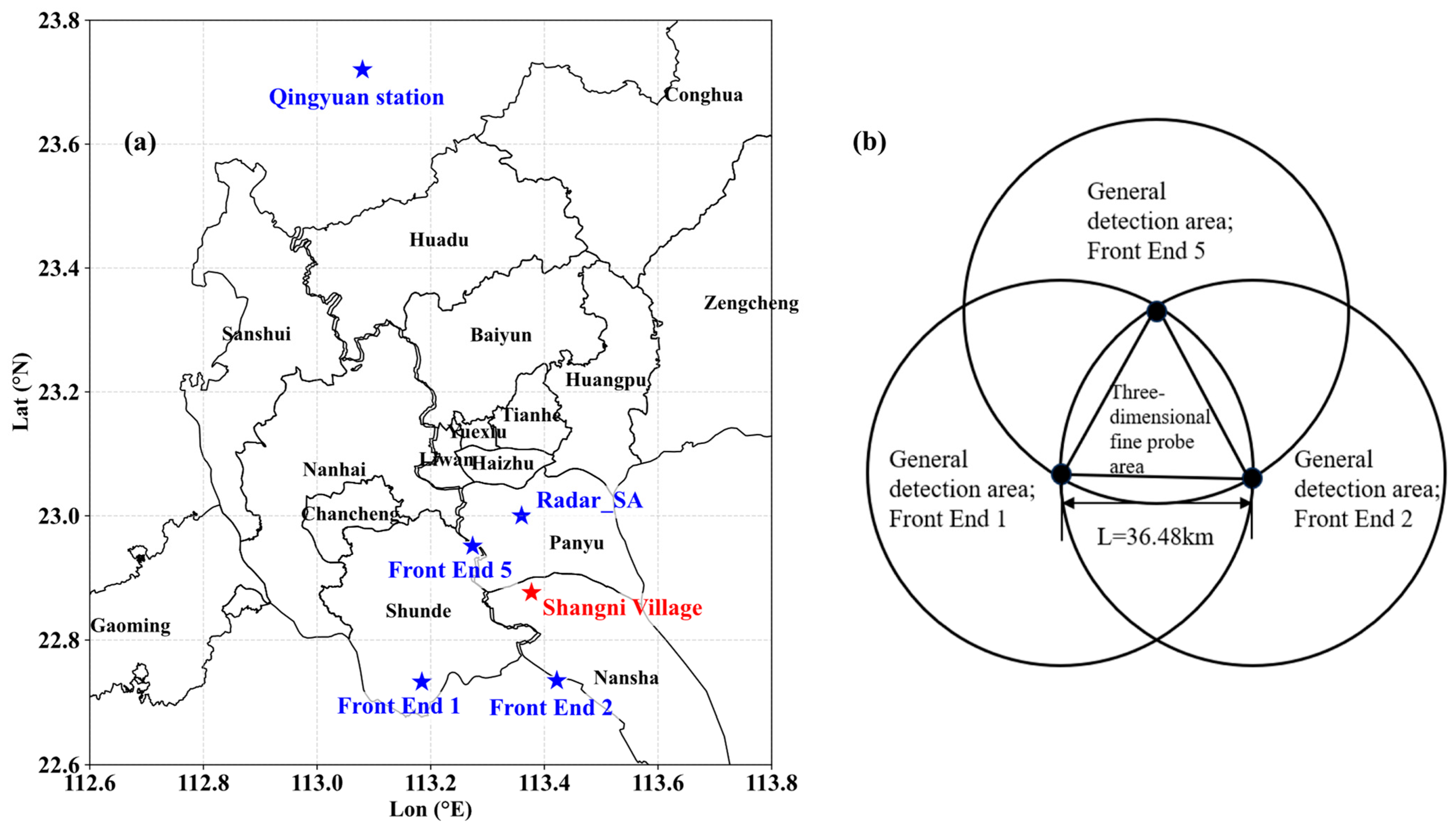
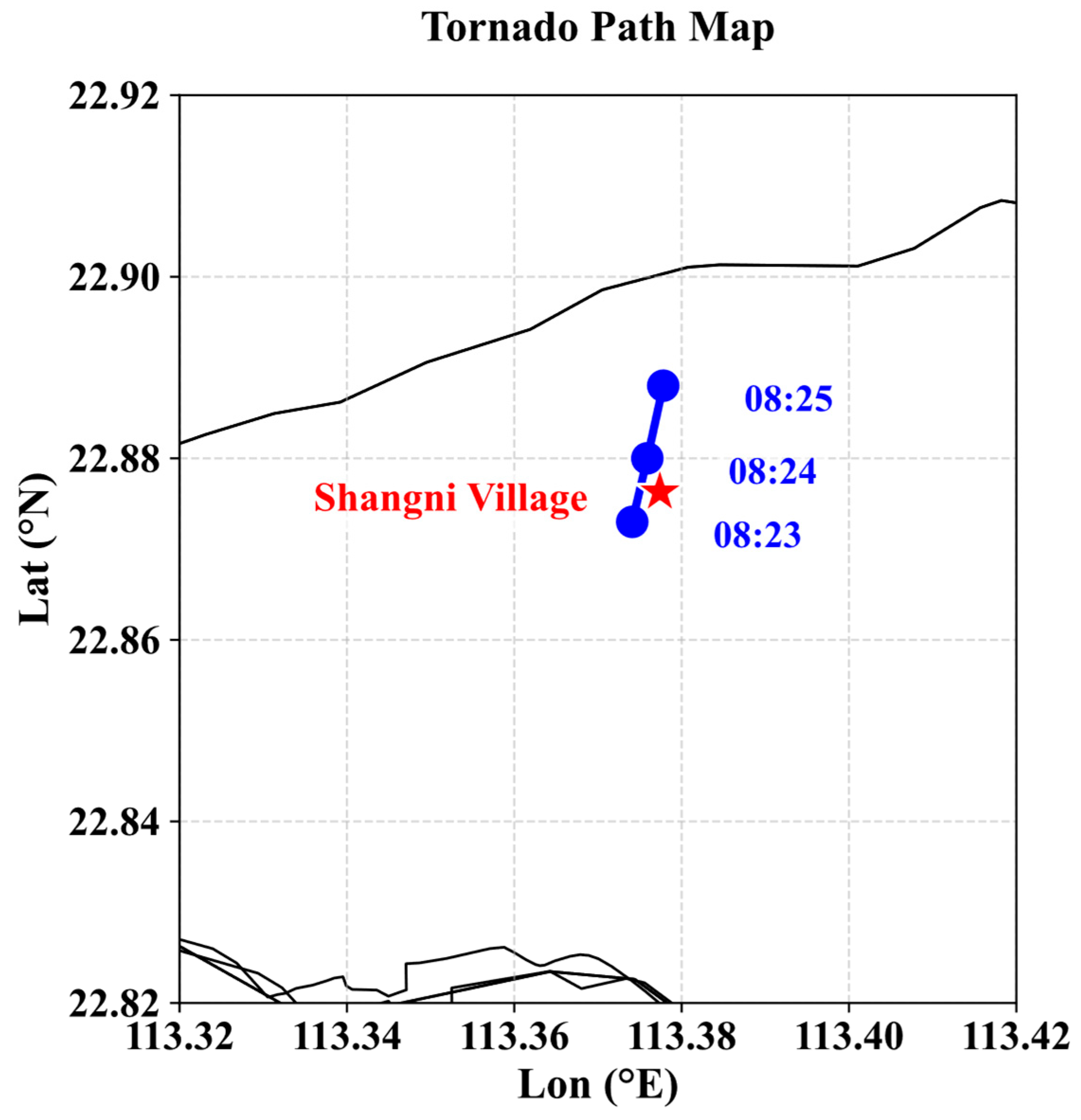
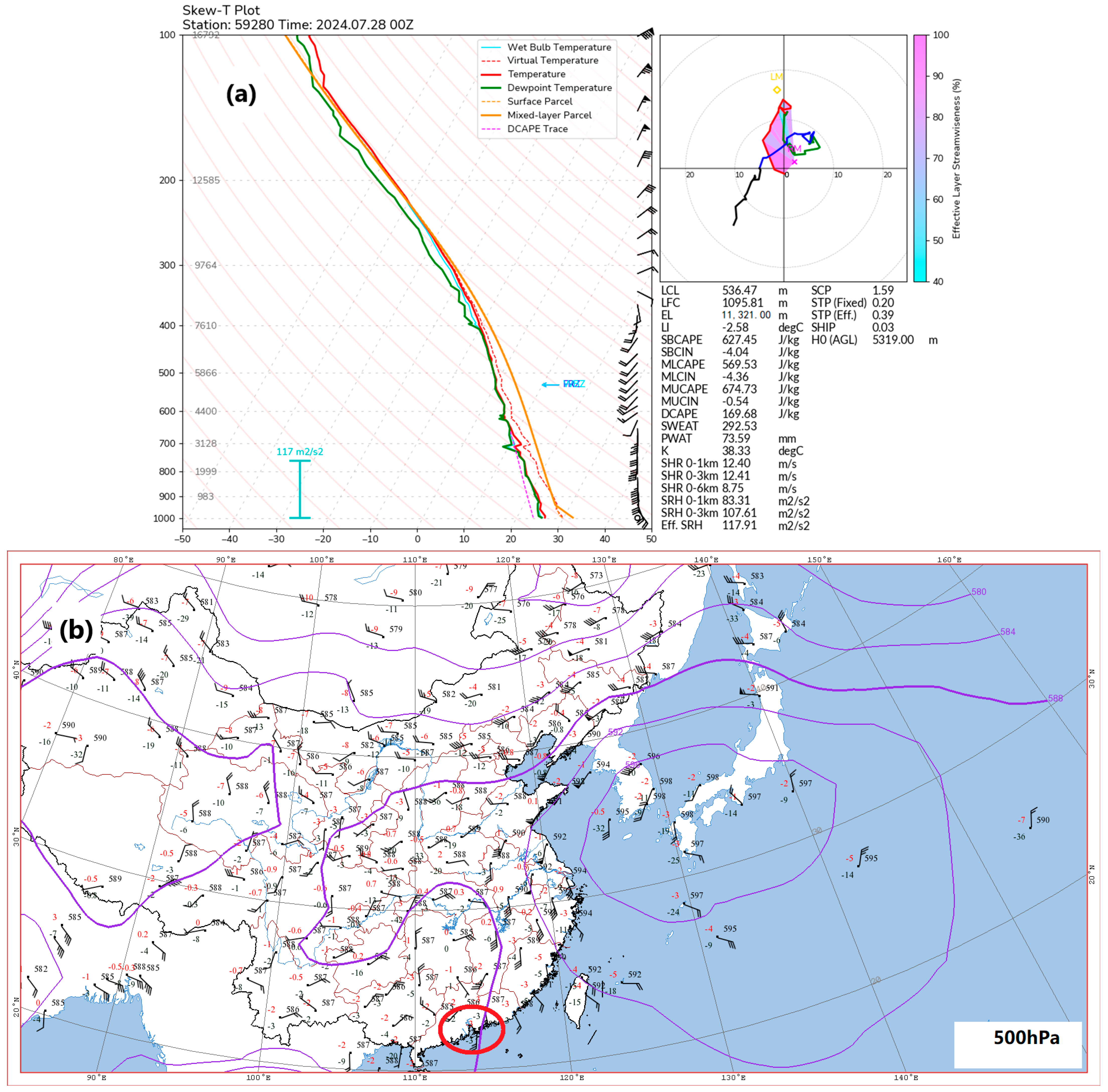
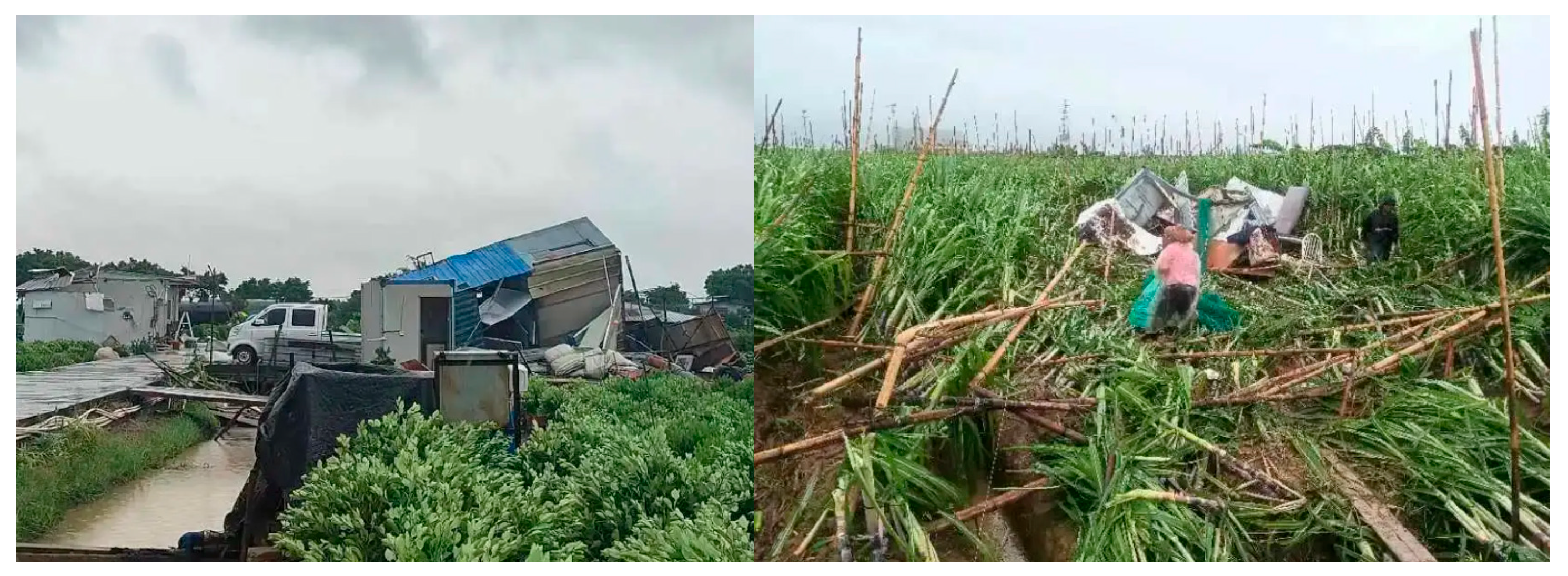
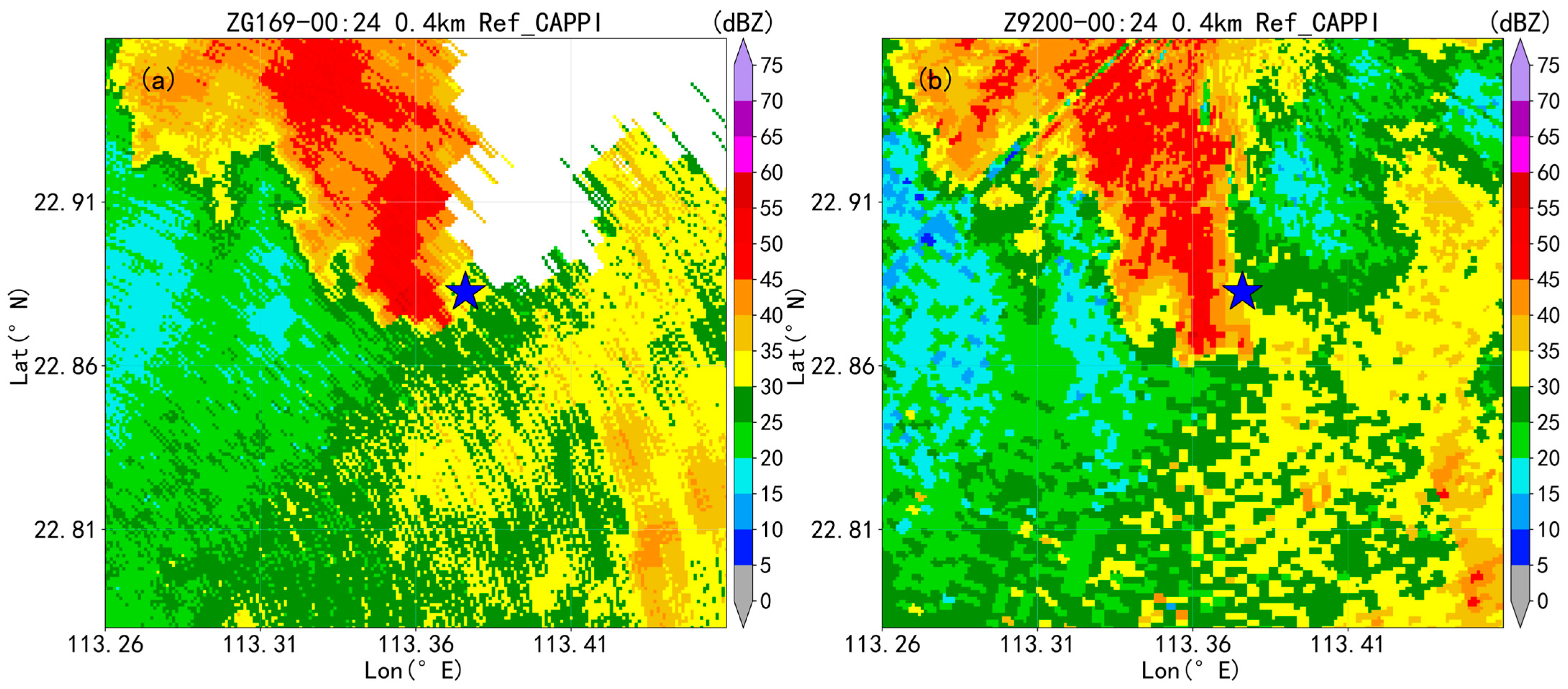
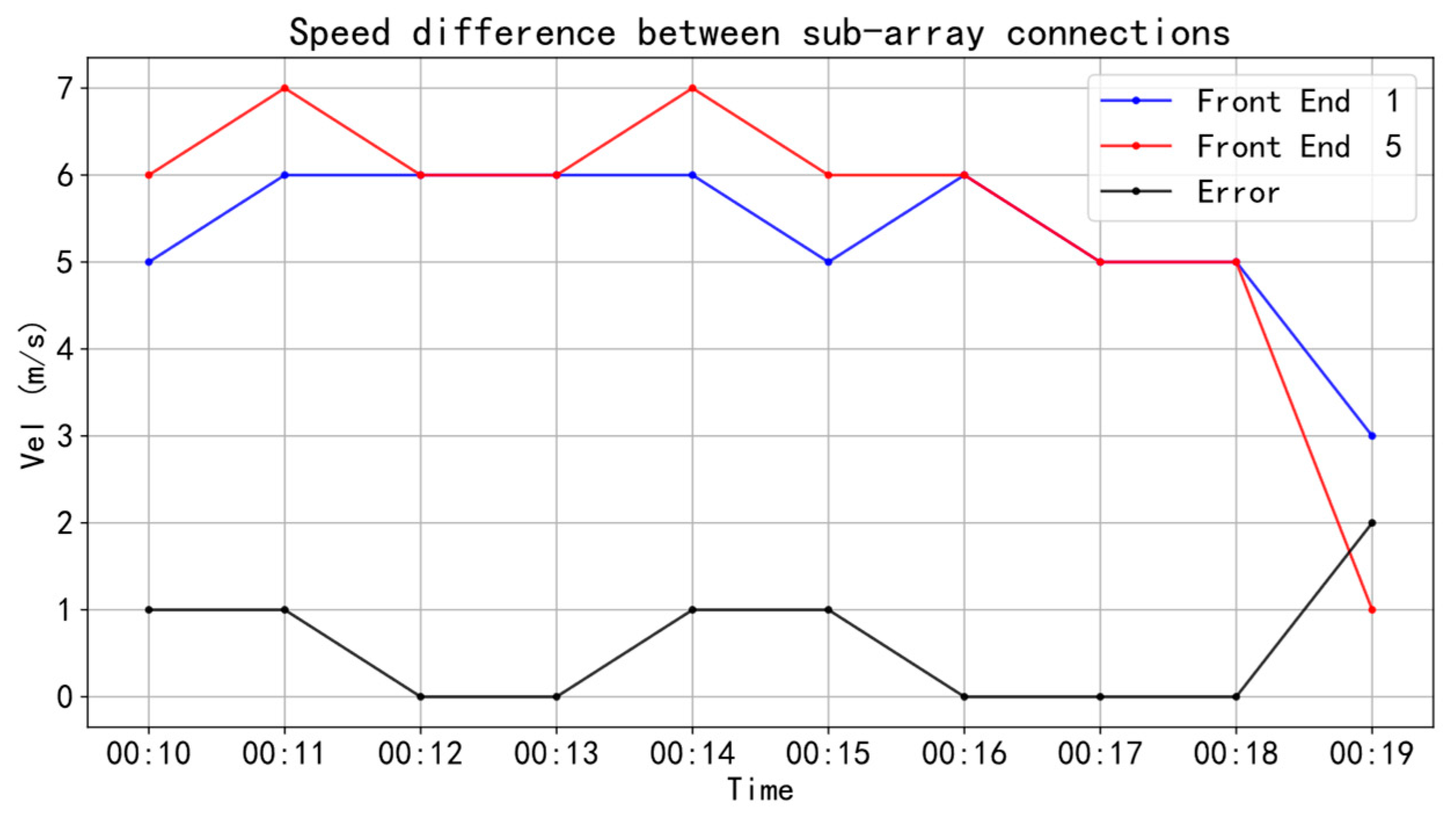
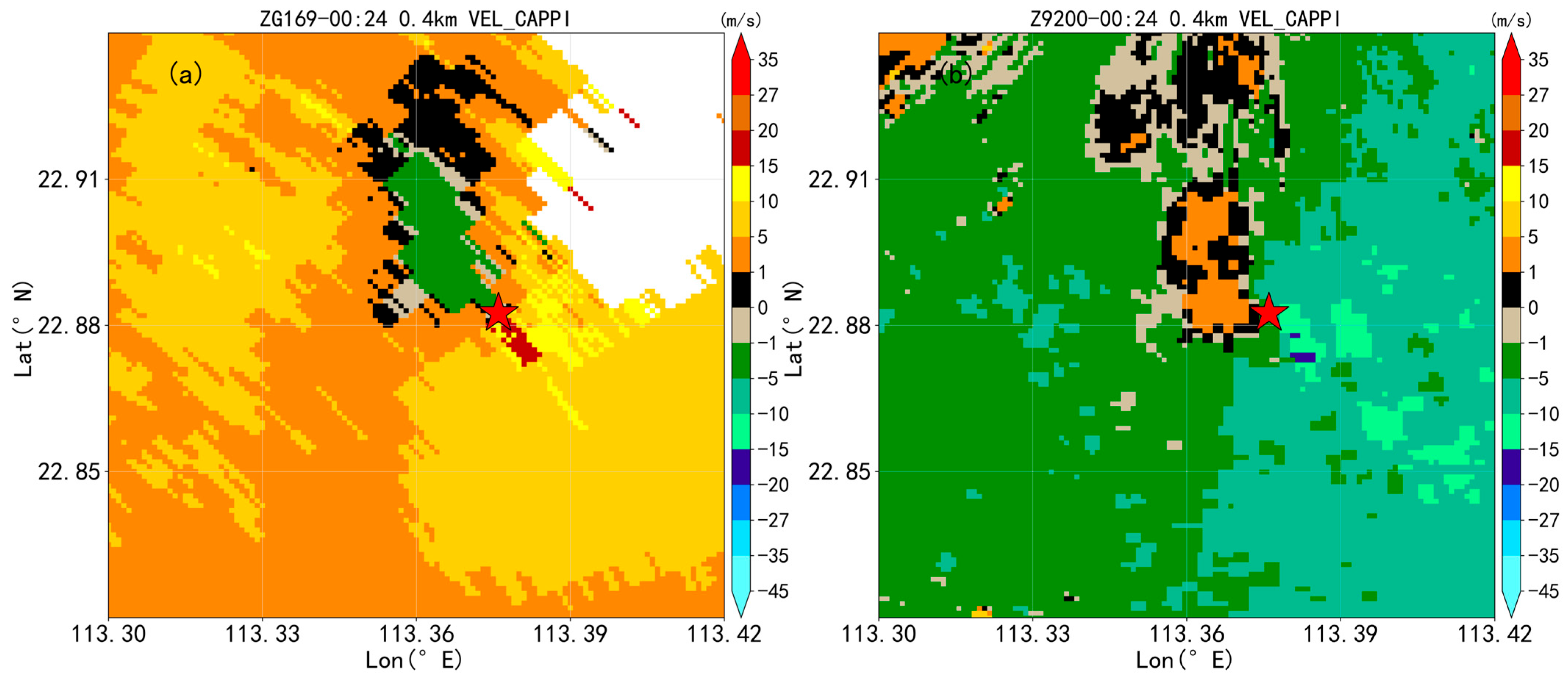


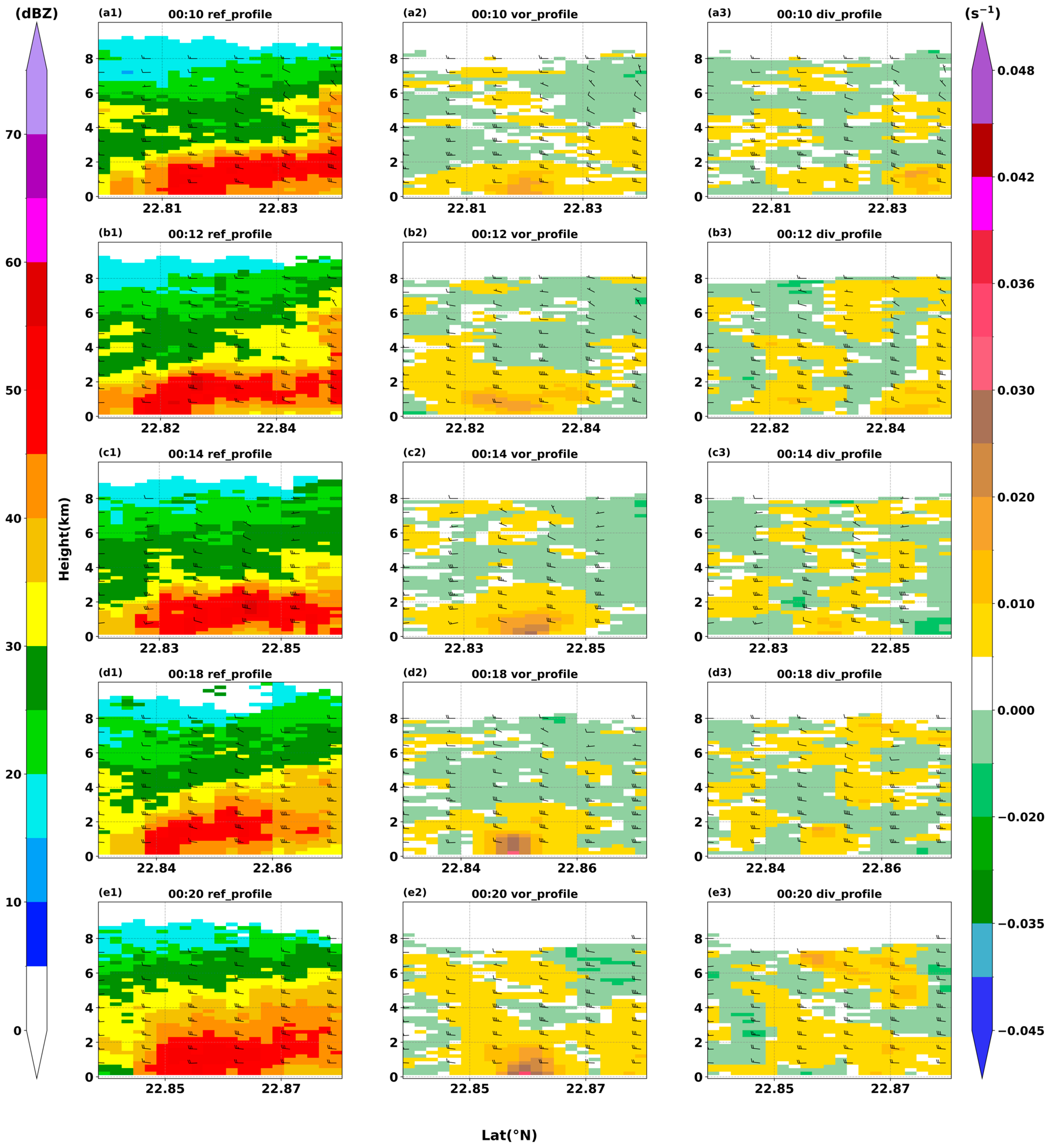


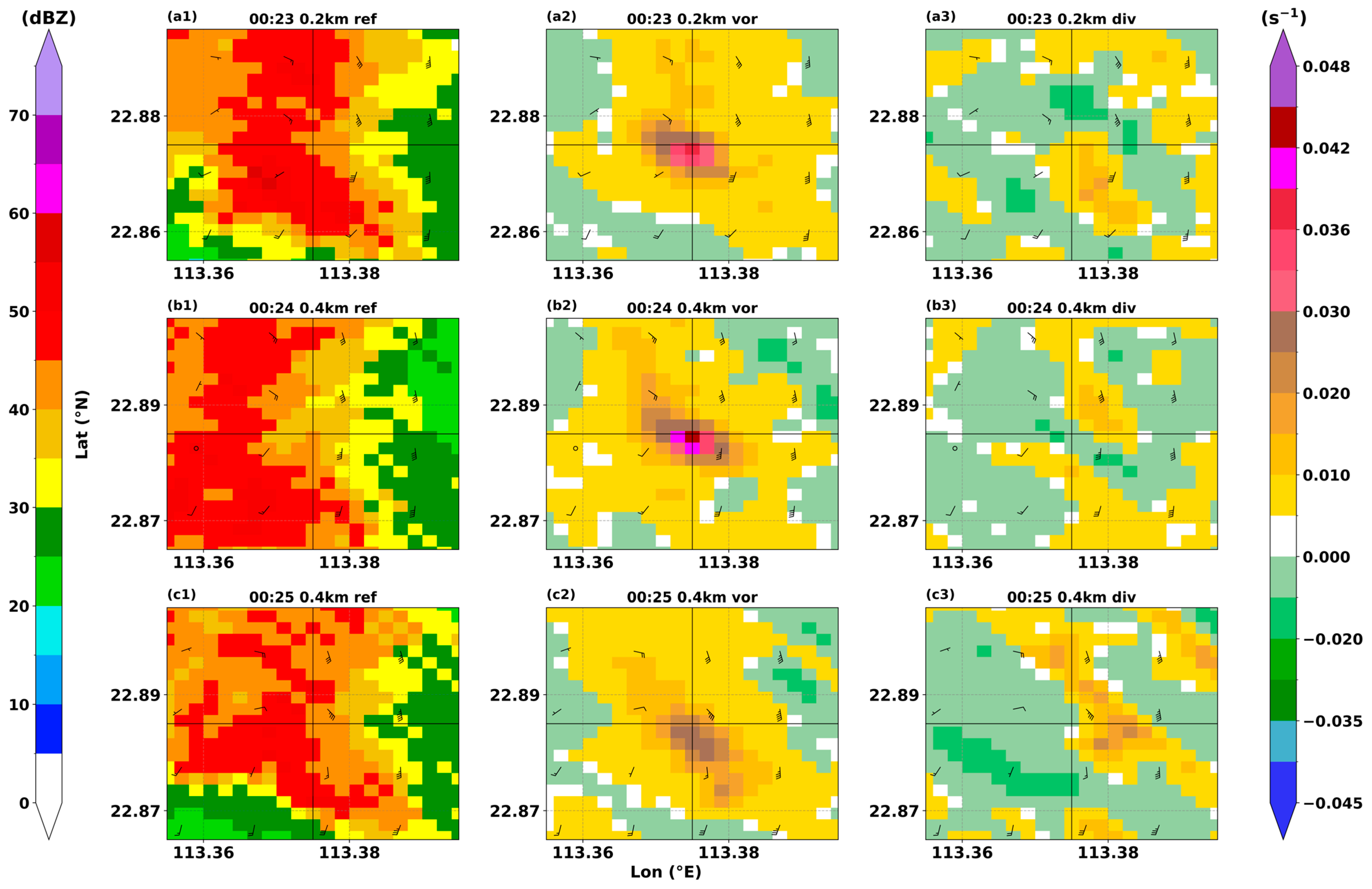
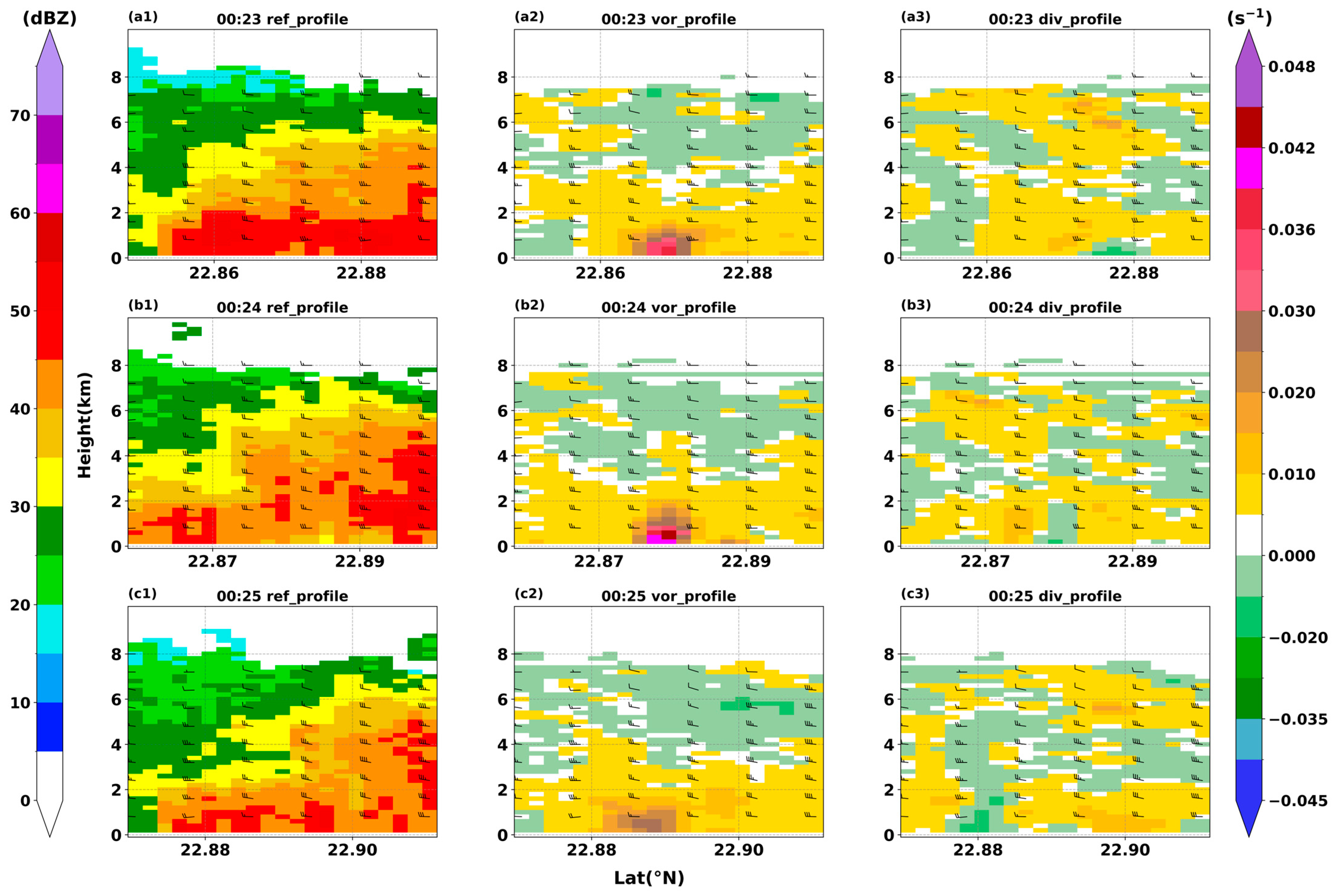

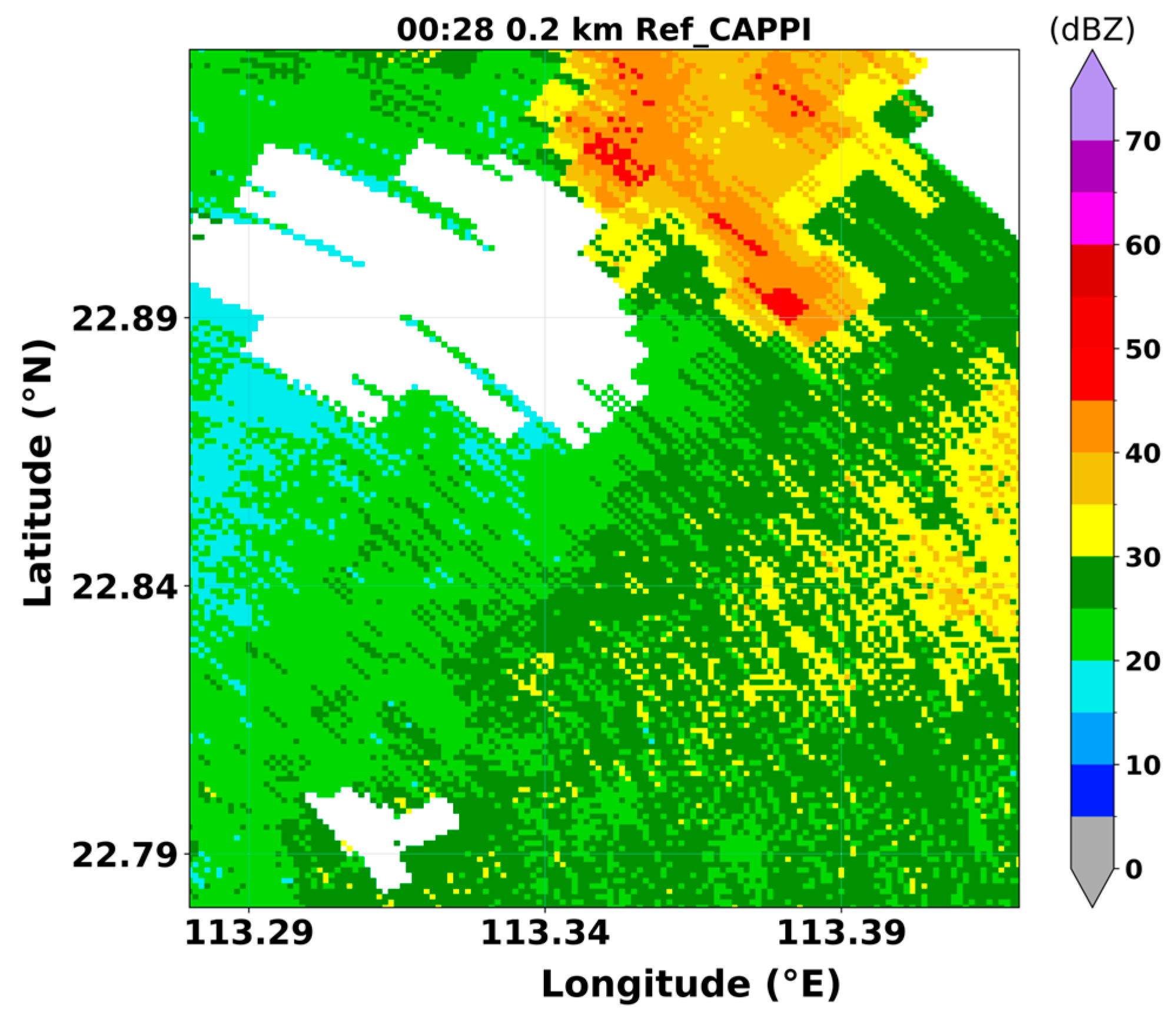

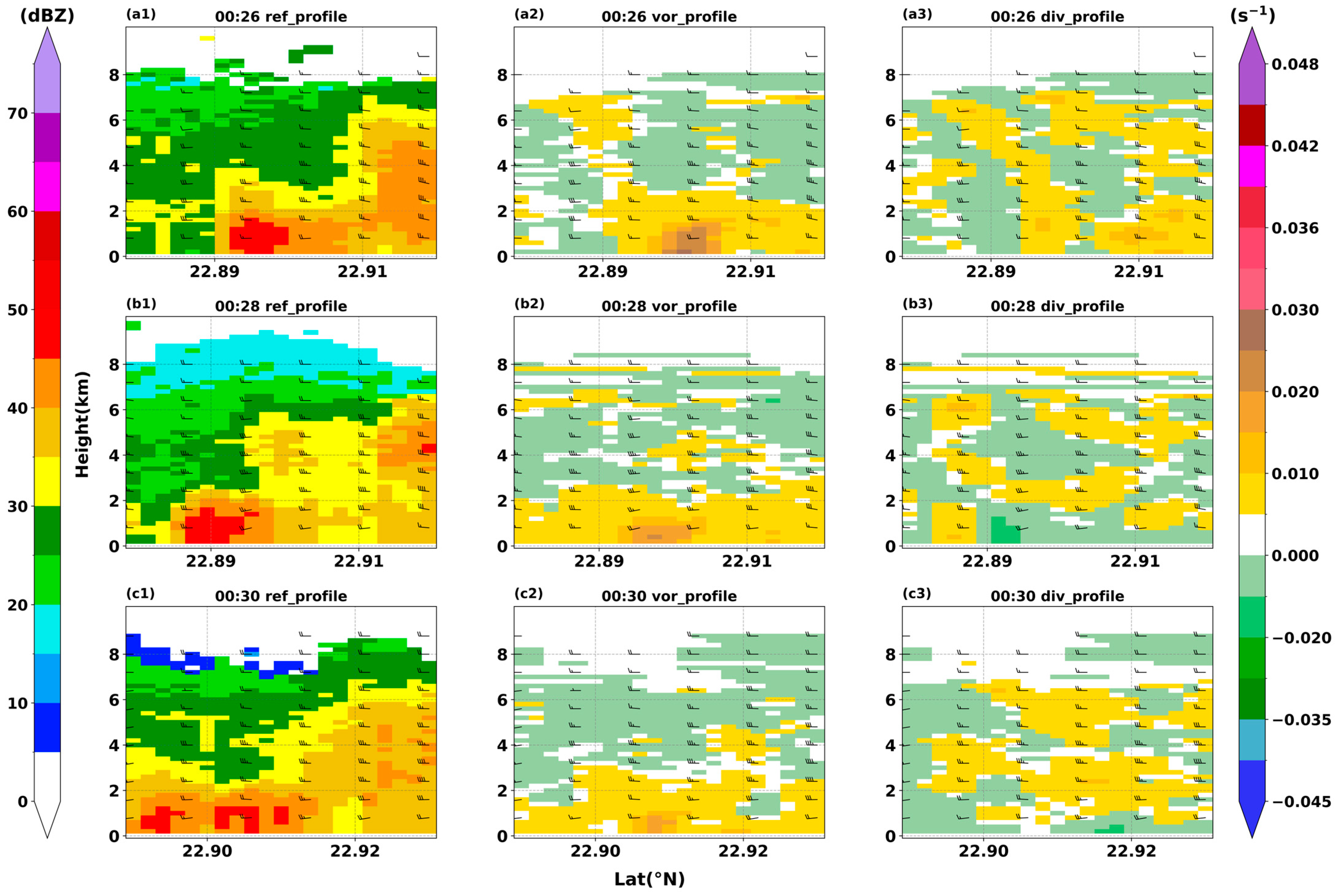

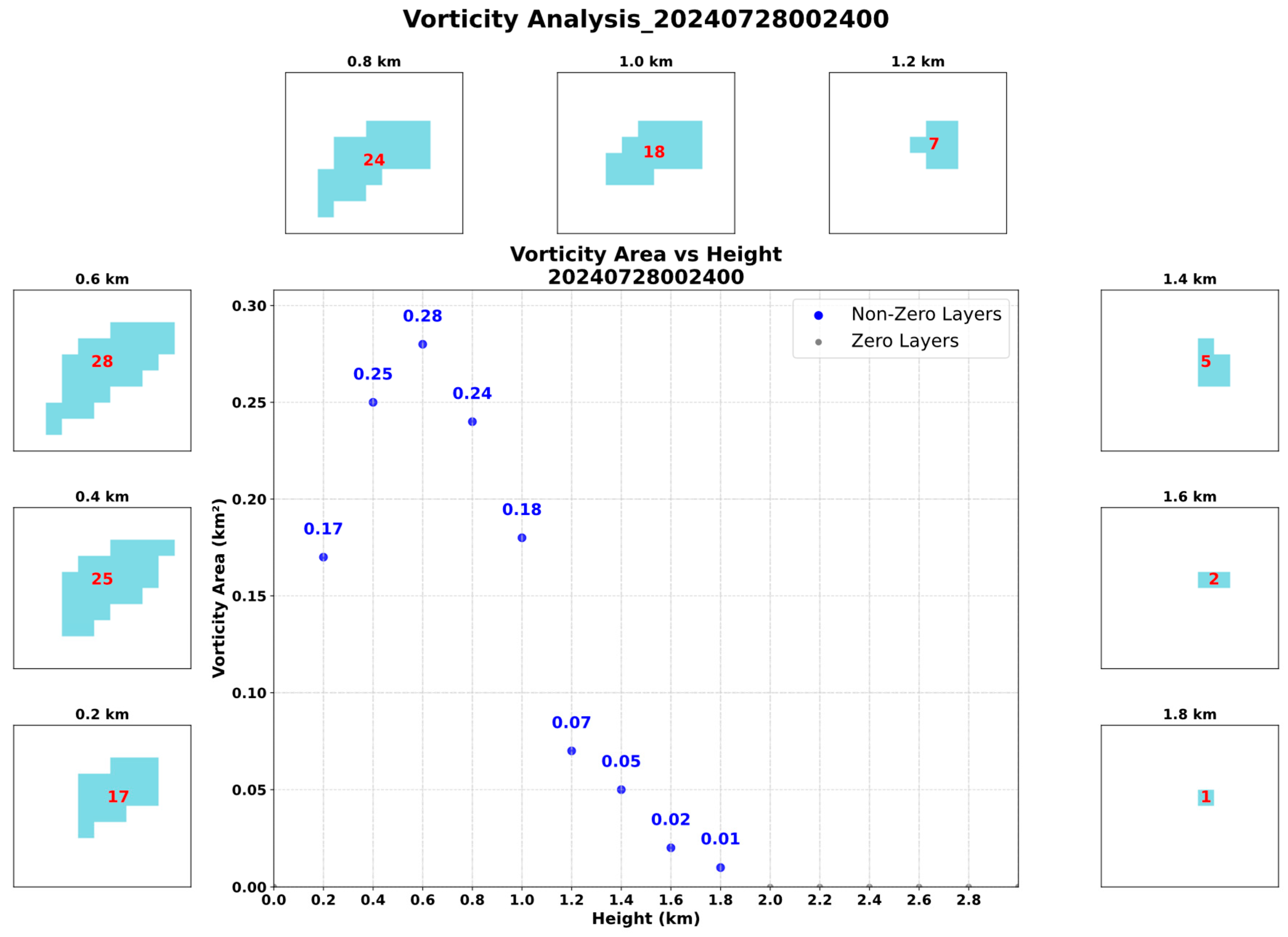

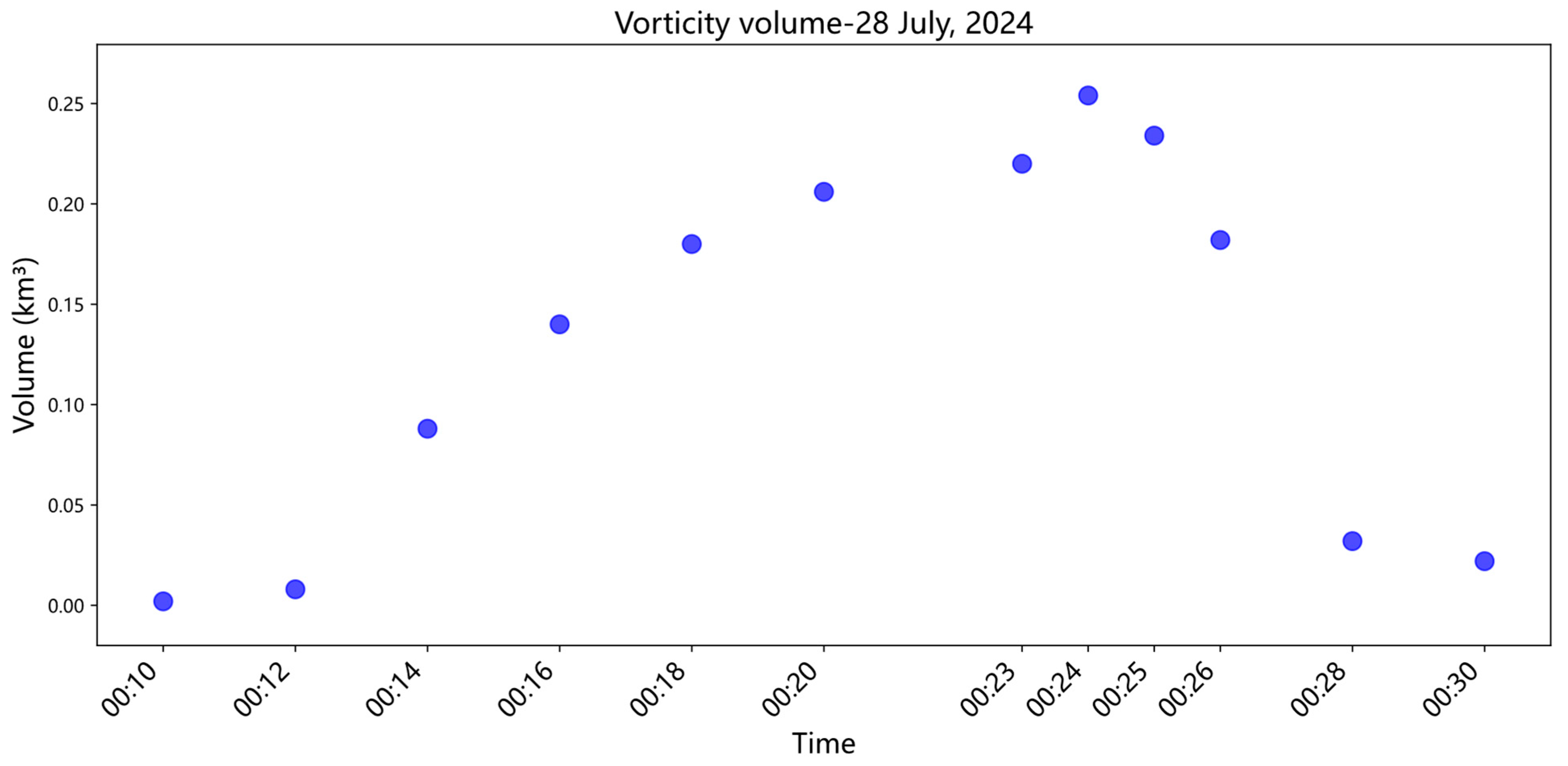


| S-Band Weather Radar | X-Band Array Weather Radar | |
|---|---|---|
| Range bin length (km) | 0.25 | 0.03 |
| Grid resolution (km) | 1 | 0.2 |
| Volume scan time (s) | 360 | 30 |
| Time | Vortex Position |
| 00:10 | (113.3602°E, 22.820°N) |
| 00:12 | (113.3621°E, 22.828°N) |
| 00:14 | (113.3640°E, 22.835°N) |
| 00:16 | (113.3661°E, 22.843°N) |
| 00:18 | (113.3679°E, 22.850°N) |
| 00:20 | (113.3702°E, 22.858°N) |
| 00:23 | (113.3741°E, 22.873°N) |
| 00:24 | (113.3759°E, 22.880°N) |
| 00:25 | (113.3778°E, 22.888°N) |
| 00:26 | (113.3800°E, 22.895°N) |
| 00:28 | (113.3819°E, 22.902°N) |
| 00:30 | (113.3837°E, 22.910°N) |
Disclaimer/Publisher’s Note: The statements, opinions and data contained in all publications are solely those of the individual author(s) and contributor(s) and not of MDPI and/or the editor(s). MDPI and/or the editor(s) disclaim responsibility for any injury to people or property resulting from any ideas, methods, instructions or products referred to in the content. |
© 2025 by the authors. Licensee MDPI, Basel, Switzerland. This article is an open access article distributed under the terms and conditions of the Creative Commons Attribution (CC BY) license (https://creativecommons.org/licenses/by/4.0/).
Share and Cite
Zhou, X.; Yang, L.; Ma, S.; Wang, R.; Li, Z.; Song, Y.; Gao, Y.; Xu, J. Analysis of the Dynamic Process of Tornado Formation on 28 July 2024. Remote Sens. 2025, 17, 2615. https://doi.org/10.3390/rs17152615
Zhou X, Yang L, Ma S, Wang R, Li Z, Song Y, Gao Y, Xu J. Analysis of the Dynamic Process of Tornado Formation on 28 July 2024. Remote Sensing. 2025; 17(15):2615. https://doi.org/10.3390/rs17152615
Chicago/Turabian StyleZhou, Xin, Ling Yang, Shuqing Ma, Ruifeng Wang, Zhaoming Li, Yuchen Song, Yongsheng Gao, and Jinyan Xu. 2025. "Analysis of the Dynamic Process of Tornado Formation on 28 July 2024" Remote Sensing 17, no. 15: 2615. https://doi.org/10.3390/rs17152615
APA StyleZhou, X., Yang, L., Ma, S., Wang, R., Li, Z., Song, Y., Gao, Y., & Xu, J. (2025). Analysis of the Dynamic Process of Tornado Formation on 28 July 2024. Remote Sensing, 17(15), 2615. https://doi.org/10.3390/rs17152615





